Tokyo Monorail
The Tokyo Monorail (東京モノレール, Tōkyō Monorēru), officially the Tokyo Monorail Haneda Airport Line (東京モノレール羽田空港線, Tōkyō Monorēru Haneda Kūkō sen), is a straddle-beam, Alweg-type monorail line in Tokyo, Japan. An airport rail link, it connects Tokyo International Airport (Haneda) to Tokyo's Ōta, Shinagawa, and Minato wards. The 17.8-kilometer (11.1 mi) line serves 11 stations between the Monorail Hamamatsuchō and Haneda Airport Terminal 2 stations. It runs on a predominantly elevated north–south route that follows the western coast of Tokyo Bay. The monorail is operated by Tokyo Monorail Co., Ltd., which is jointly owned by JR East, Hitachi, and All Nippon Airways. It carried an average of 140,173 passengers in 2018.
| Tokyo Monorail Haneda Airport Line | ||||||||||||||||||||||||||||||||||||||||||||||||||||||||||||||||||||||||||||||||||||||||||||||||||||||||||||||||||||||||||||||||||||||||||||||||||
|---|---|---|---|---|---|---|---|---|---|---|---|---|---|---|---|---|---|---|---|---|---|---|---|---|---|---|---|---|---|---|---|---|---|---|---|---|---|---|---|---|---|---|---|---|---|---|---|---|---|---|---|---|---|---|---|---|---|---|---|---|---|---|---|---|---|---|---|---|---|---|---|---|---|---|---|---|---|---|---|---|---|---|---|---|---|---|---|---|---|---|---|---|---|---|---|---|---|---|---|---|---|---|---|---|---|---|---|---|---|---|---|---|---|---|---|---|---|---|---|---|---|---|---|---|---|---|---|---|---|---|---|---|---|---|---|---|---|---|---|---|---|---|---|---|---|---|
| MO | ||||||||||||||||||||||||||||||||||||||||||||||||||||||||||||||||||||||||||||||||||||||||||||||||||||||||||||||||||||||||||||||||||||||||||||||||||
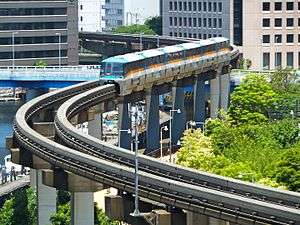 A train passing through Tennōzu in Shinagawa | ||||||||||||||||||||||||||||||||||||||||||||||||||||||||||||||||||||||||||||||||||||||||||||||||||||||||||||||||||||||||||||||||||||||||||||||||||
| Overview | ||||||||||||||||||||||||||||||||||||||||||||||||||||||||||||||||||||||||||||||||||||||||||||||||||||||||||||||||||||||||||||||||||||||||||||||||||
| Native name | 東京モノレール羽田空港線 | |||||||||||||||||||||||||||||||||||||||||||||||||||||||||||||||||||||||||||||||||||||||||||||||||||||||||||||||||||||||||||||||||||||||||||||||||
| Type | Straddle-beam monorail (Alweg-type) | |||||||||||||||||||||||||||||||||||||||||||||||||||||||||||||||||||||||||||||||||||||||||||||||||||||||||||||||||||||||||||||||||||||||||||||||||
| Locale | Tokyo, Japan | |||||||||||||||||||||||||||||||||||||||||||||||||||||||||||||||||||||||||||||||||||||||||||||||||||||||||||||||||||||||||||||||||||||||||||||||||
| Termini | Monorail Hamamatsuchō (north) Haneda Airport Terminal 2 (south) | |||||||||||||||||||||||||||||||||||||||||||||||||||||||||||||||||||||||||||||||||||||||||||||||||||||||||||||||||||||||||||||||||||||||||||||||||
| Stations | 11 | |||||||||||||||||||||||||||||||||||||||||||||||||||||||||||||||||||||||||||||||||||||||||||||||||||||||||||||||||||||||||||||||||||||||||||||||||
| Daily ridership | 140,173 (2018, average)[1] | |||||||||||||||||||||||||||||||||||||||||||||||||||||||||||||||||||||||||||||||||||||||||||||||||||||||||||||||||||||||||||||||||||||||||||||||||
| Website | Tokyo Monorail | |||||||||||||||||||||||||||||||||||||||||||||||||||||||||||||||||||||||||||||||||||||||||||||||||||||||||||||||||||||||||||||||||||||||||||||||||
| Operation | ||||||||||||||||||||||||||||||||||||||||||||||||||||||||||||||||||||||||||||||||||||||||||||||||||||||||||||||||||||||||||||||||||||||||||||||||||
| Opened | September 17, 1964 | |||||||||||||||||||||||||||||||||||||||||||||||||||||||||||||||||||||||||||||||||||||||||||||||||||||||||||||||||||||||||||||||||||||||||||||||||
| Owner | Tokyo Monorail Co., Ltd. | |||||||||||||||||||||||||||||||||||||||||||||||||||||||||||||||||||||||||||||||||||||||||||||||||||||||||||||||||||||||||||||||||||||||||||||||||
| Character | Elevated and underground[2] | |||||||||||||||||||||||||||||||||||||||||||||||||||||||||||||||||||||||||||||||||||||||||||||||||||||||||||||||||||||||||||||||||||||||||||||||||
| Technical | ||||||||||||||||||||||||||||||||||||||||||||||||||||||||||||||||||||||||||||||||||||||||||||||||||||||||||||||||||||||||||||||||||||||||||||||||||
| Line length | 17.8 km (11.1 mi) | |||||||||||||||||||||||||||||||||||||||||||||||||||||||||||||||||||||||||||||||||||||||||||||||||||||||||||||||||||||||||||||||||||||||||||||||||
| Minimum radius | 120 m (390 ft) | |||||||||||||||||||||||||||||||||||||||||||||||||||||||||||||||||||||||||||||||||||||||||||||||||||||||||||||||||||||||||||||||||||||||||||||||||
| Operating speed |
| |||||||||||||||||||||||||||||||||||||||||||||||||||||||||||||||||||||||||||||||||||||||||||||||||||||||||||||||||||||||||||||||||||||||||||||||||
| ||||||||||||||||||||||||||||||||||||||||||||||||||||||||||||||||||||||||||||||||||||||||||||||||||||||||||||||||||||||||||||||||||||||||||||||||||
Plans to build Japan's first airport rail link surfaced in 1959 as Tokyo was preparing to host the 1964 Summer Olympics. That year, the Yamato Kanko Co., Ltd.—later renamed Tokyo Monorail Co., Ltd.—was established to build the rail connection, selecting an Alweg monorail system. Construction began in 1963 and completed on September 17, 1964, just 23 days ahead of the Olympic opening ceremony. Upon opening, the monorail operated between the Hamamatsuchō and Haneda stations, making no intermediate stops. It has since been expanded with various infill stations and extensions.
The Tokyo Monorail is one of two rail lines serving the airport, with the other being the Keikyū Airport Line. At Hamamatsuchō Station, passengers may transfer to the Keihin–Tōhoku and Yamanote lines of JR East, as well as the Asakusa and Oedo lines of the Toei Subway via nearby Daimon Station. The monorail also connects with Tokyo Waterfront Area Rapid Transit's Rinkai Line at Tennōzu Isle Station.
Early history
.jpg)
By the time Japan's commercial aviation industry recovered from the Second World War in the early 1950s, Tokyo's Haneda Airport had emerged as the country's largest transport hub and international gateway. In 1959, the airport recorded approximately 910,000 total passengers and expected many more for the coming 1964 Summer Olympics. As a result, the government unveiled a plan for a central Tokyo-to-airport rail link. Opponents of the rail line briefly countered with a proposal to extend the Tokyo Expressway instead, but fears that this would only worsen vehicular congestion led to a preference for rail.[3]:9
In August 1959, the Yamato Kanko Co., Ltd. was established to build the rail line; it renamed to Japan Elevated Railway Co., Ltd. a year later. The company applied for a route license to build a straddle-beam, Alweg-type monorail in January 1960, which the Japanese government granted the following December.[4] The company selected Alweg due to two factors. First, the company's president, Tetsuzo Inumaru, was an old friend of Dr. Axel Wenner-Gren, the founder of Alweg. Second, Hitachi, Ltd., which would build the line, was keen on further developing the technology.[3]:9
Project planners originally intended the monorail line to extend from Haneda Airport to Shimbashi or Tokyo Station,[5] and the license that had been acquired allowed building it up to either station.[6]:3 However, opposition from residents living near the Shibaura Canal, which had been part of the proposed route,[7] as well as cost overruns during the construction of the Tōkaidō Shinkansen, which drained government subsidies, resulted in a shortened route from the airport to Hamamatsuchō Station. To further minimize costs, the line was routed over other public waterways donated by local municipalities, which eliminated the need to acquire expensive private land, but reclaimed parts of Tokyo Bay, as well as rivers and canals. The resulting alignment removed a number of fishing and aquatic farming operations, and local fishing cooperatives had their licences revoked by the Tokyo Metropolitan Government. Among them was a seaweed harvesting field in Ōta Ward that had produced a premium brand of nori since the Edo period called Omori no nori.[5]
The Ministry of Transport authorized the monorail project in December 1961.[3]:9 A groundbreaking ceremony was held on May 1, 1963, and the subsequent construction of the line progressed rapidly.[8]:248 In May 1964, Japan Elevated Railway Co., Ltd. again changed its name to Tokyo Monorail Co., Ltd.[4] The line cost a total of 21.1 billion yen (equivalent to approximately $60 million in 1964 dollars[9]), of which 20 billion yen was spent for construction and 1.1 billion yen on rolling stock.[3]:9 Hitachi built the first-generation cars in Japan, which were inspired by the original Alweg design developed for the Seattle Center Monorail and the original Disneyland Monorail. Upon its inauguration, the Tokyo Monorail became the world's first commercial monorail service and Japan's first airport rail connection.[10][11]
Service commenced on September 17, 1964, 23 days ahead of the Olympic opening ceremony on October 10.[12] At the time of opening, the Tokyo Monorail ran a total length of 13.1 kilometers (8.1 mi) and served only its termini: Hamamatsuchō Station and the airport. Most of the artificial islands in Tokyo Bay had not yet been reclaimed, and the line mostly ran over water.[13] The price for a one-way ticket was 250 yen,[14][15] which was relatively more expensive than other available options at the time. It was notably cheaper to take a taxi with four people to the airport than to ride the monorail. A recession following the Olympics resulted in a decrease in airport arrivals, which severely affected ridership. In 1966, the Tokyo Monorail was forced to reduce the price of its fare to 150 yen to attract more passengers.[13]
Infill stations and later expansions
Ōi Keibajō Mae became the monorail's first infill station upon its completion in May 1965. It was originally built as a temporary station above the water along the coast and only operated on days when an event was taking place at Ohi Racecourse. Its permanent replacement opened two years later. The city government subsequently reclaimed the area around this station and developed a housing complex known as Yashio Park Town.[13] In November 1967, an overpass connecting the monorail platform to the JR platforms of Hamamatsuchō Station was completed.[4] Between 1967 and 1993, four more stations were built along the original alignment. These were Haneda Seibijō, later renamed Seibijō (1967); Shin Heiwajima, later renamed Ryūtsū Center (1969); Shōwajima (1985); and Tennōzu Isle (1992).[6]:3
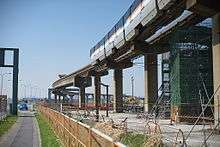
When the monorail began operating, the passenger terminal at Haneda Airport was located on the west side of the airfield, south of Seibijō, and this was the southern end of the line. Upon the opening of a new passenger terminal—now Terminal 1—in 1993, the monorail was extended to a new platform and another station, Shin Seibijō, was built for the employees of nearby maintenance facilities.[6]:4 Meanwhile, the former passenger terminal was razed and the monorail tunnel beneath it abandoned to make room for an extension of Runway B.[16] The original Haneda Station, which was abandoned along with the tunnel, was rebuilt farther west along the new section of tracks and renamed Tenkūbashi Station in November 1998.[17] Although the rails were removed and its entrance walled off, the now-unused tunnel remains otherwise intact today below the Runway B extension.[16]
The monorail has continued to adapt and expand with the terminal changes and expansions of Haneda Airport. A single-station, 0.9-kilometer (0.56 mi) extension to the airport's then new Terminal 2 opened on December 1, 2004, and resulted in the renaming of the existing Haneda Airport Station to Haneda Airport Terminal 1 Station. The opening of a passing loop at Shōwajima allowed for the operation of express services from March 18, 2007.[4] A new infill station to serve the airport's new International Terminal opened on October 21, 2010. On March 14, 2020, the three stations serving Haneda Airport were renamed to coincide with the renaming of the International Terminal to Terminal 3. In Japanese, the word "building" (ビル, biru) in the station names was modified to "terminal" (ターミナル, tāminaru). From north–south, the stations are Haneda Airport Terminal 3 Station (羽田空港第3ターミナル駅), Haneda Airport Terminal 1 Station (羽田空港第1ターミナル駅), and Haneda Airport Terminal 2 Station (羽田空港第2ターミナル駅).[18][19]
Planned extension to Tokyo Station
In June 2009, Tokyo Monorail Co., Ltd., formally notified the Ministry of Land, Infrastructure and Transport of its intent to convert the present single-track terminal at Hamamatsucho, which had rested unchanged since 1964, into a dual-track, dual-platform structure. To be built in six and a half years at an estimated cost of 26 billion yen, this would increase the line's capacity from 18 to 24 trains per hour and lay the groundwork for a long-mooted extension to Shimbashi Station.[20] In August 2014, it was revealed that the line could be extended from Hamamatsucho to Tokyo Station, running alongside the Yamanote Line tracks between Shimbashi and Tokyo. Total costs are estimated at 109.5 billion yen, with construction taking approximately ten years.[21][22]
Route
The Tokyo Monorail is 17.8 kilometers (11.1 mi) long.[6]:12 It traverses Tokyo's Minato, Shinagawa, and Ōta wards. The line's northern terminus is Monorail Hamamatsuchō Station. From there, the tracks travel southbound, crossing over various other lines including the Yamanote, Keihin–Tōhoku, and Tokaido Shinkansen lines.[23]
Service patterns
The following three service types operate on the line:
- Local (普通, Futsū)
- Rapid (区間快速, Kukan Kaisoku)
- Haneda Express (空港快速, Kūkō Kaisoku)
Tokyo Monorail trains operate on an average headway of four minutes. This can be as short as three minutes and 20 seconds during peak hours.[6]:2[24]:33 "Local" trains stop at every station, with end-to-end travel taking 24 minutes. "Rapid" trains bypass the Shōwajima, Seibijō, Tenkūbashi, Shin Seibijō stations, and take 21 minutes to travel across the line. "Haneda Express" trains make non-stop runs between Monorail Hamamatsuchō Station and Haneda Airport; these trains arrive at Haneda Airport Terminal 3 in 13 minutes, Haneda Airport Terminal 1 in 16 minutes, and Haneda Airport Terminal 2 in 18 minutes.[25] The Tokyo Monorail started operating "Rapid" (快速, Kaisoku) trains in December 2001, which departed from Haneda Airport at 11:50 pm; these trains began running all day three years later. In March 2007, the monorail replaced its original "Rapid" service with the two existing "Haneda Express" and "Rapid" service patterns.[4]
Stations
| Key | |
|---|---|
| ● | Stops at this station |
| Skips this station | |
| No. | Image | Name | Japanese | Distance(km) | Local | Rapid | HanedaExpress | Connections and notes[25] | Location |
|---|---|---|---|---|---|---|---|---|---|
| MO01 | Monorail Hamamatsuchō | モノレール浜松町 | 0.0 | ● | ● | ● | JK Keihin–Tōhoku LineJY Yamanote LineA Asakusa Line (via Daimon Station)E Oedo Line (via Daimon Station) | Minato | |
| MO02 | 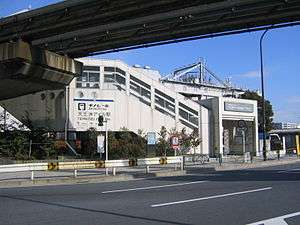 |
Tennōzu Isle | 天王洲アイル | 4.0 | ● | ● | R Rinkai Line | Shinagawa | |
| MO03 |  |
Ōi Keibajō Mae | 大井競馬場前 | 7.1 | ● | ● | — | ||
| MO04 |  |
Ryūtsū Center | 流通センター | 8.7 | ● | ● | — | Ōta | |
| MO05 |  |
Shōwajima | 昭和島 | 9.9 | ● | — | |||
| MO06 |  |
Seibijō | 整備場 | 11.8 | ● | — | |||
| MO07 |  |
Tenkūbashi | 天空橋 | 12.6 | ● | KK Keikyū Airport Line | |||
| MO08 | Haneda Airport Terminal 3 | 羽田空港第3ターミナル | 14.0 | ● | ● | ● | KK Keikyū Airport LineName changed from Haneda Airport International Terminal Station (羽田空港国際線ビル駅) on March 14, 2020.[18] | ||
| MO09 |  |
Shin Seibijō | 新整備場 | 16.1 | ● | — | |||
| MO10 | 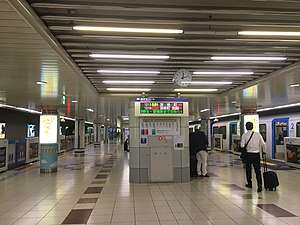 |
Haneda Airport Terminal 1 | 羽田空港第1ターミナル | 16.9 | ● | ● | ● | KK Keikyū Airport Line (via Haneda Airport Terminal 1·2 Station)Name changed in Japanese from 羽田空港第1ビル駅 on March 14, 2020.[18] | |
| MO11 | Haneda Airport Terminal 2 | 羽田空港第2ターミナル | 17.8 | ● | ● | ● | KK Keikyū Airport Line (via Haneda Airport Terminal 1·2 Station)Name changed in Japanese from 羽田空港第2ビル駅 on March 14, 2020.[18] |
Rolling Stock
As of 2020, the Tokyo Monorail operates three train types: 1000 series, 2000 series, and most recently, 10000 series. All trainsets run in a six-car configuration and are capable of running at speeds of up to 80 km/h (50 mph). Each car has a combination of aisle-facing bench seats, forward and rear-facing seats, and seats in the center of the aisle. The trains also feature extra space for hand luggage, as a convenience for air travelers. These trains are stored and maintained at Shōwajima Depot beside Shōwajima Station during off-service hours. The 1000 series trains were introduced from 1989, and the 2000 series trains were introduced from 1997.[26]
From 18 July 2014, the first of a fleet of new 10000 series 6-car trains was introduced, replacing the older 1000 series trains.[26][27]
 1000 series
1000 series 2000 series
2000 series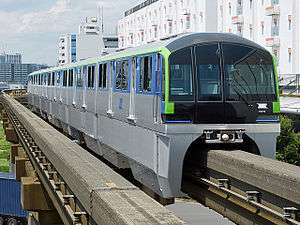 10000 series
10000 series
Former rolling stock
Former rolling stock once used on Tokyo Monorail include the 100/200/300/350 series (from 1964 until 1978), 500 series (from 1969 until 1991), 600 series (from 1977 until 1997), and 700/800 series (from 1982 until 1998).
Service
The Tokyo Monorail operates from around 5:00 a.m. to midnight with over 500 trains. The first departure towards the airport leaves at 04:58 and the last departure is at 00:01. Towards Hamamatsuchō, the first departure is at 05:11 and the final departure is at 00:05 (final departure serving all stations at 23:38). Passengers using the monorail to travel to the airport can take advantage of check-in facilities at Hamamatsuchō. Japan's domestic airlines (JAL, ANA, Skymark Airlines, and Air Do) have check-in counters and ticket machines right at the station. It carried its 1.5 billionth passenger on January 24, 2007.[28]
An alternative to the monorail is the Keikyu Airport Line between the airport and Shinagawa Station. Both railways compete with bus services.
Ownership
The monorail line is operated by the Tokyo Monorail Co., Ltd. (東京モノレール株式会社, Tōkyō Monorēru Kabushiki-gaisha). In 1967, Tokyo Monorail Co., Ltd. merged with Hitachi Transport Co., Ltd. and Western Hitachi Transport Co., Ltd. to form Hitachi Transport Tokyo Monorail Co., Ltd. after Hitachi Transport System acquired 81 percent share of the company.[8]:11 The company re-established as Tokyo Monorail Co., Ltd. in 1981.[8]:19–21 JR East acquired a 70 percent majority share of the company from Hitachi Transport System in 2002, with the remaining 30 percent going to Hitachi, Ltd.[8]:73 As of March 2012, Tokyo Monorail Co., Ltd. is divided between JR East (79 percent), Hitachi (12 percent), and All Nippon Airways (9 percent).[8]:74
Operation and maintenance
The Shōwajima Center (昭和島車両基地, Shōwajima sharyō kichi), located next to Shōwajima Station, is the operations and maintenance center of the Tokyo Monorail. The complex houses an operations control room that controls the movement of trains, a power control room that controls the line's power supply, a vehicle maintenance and storage depot where cars are inspected and serviced, a track and trolley inspection and maintenance depot, and a crew depot.
Fares
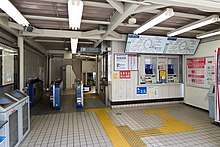
As of 2020, the Tokyo Monorail offers multiple fare types with varying lengths of validity and terms of use. One-way tickets, which are valid for the day of purchase, may be used to travel between two stations without making intermediate stops. Return tickets are similar but allow for a return trip; these are valid if returning to any Haneda Airport station within 10 days and to other stations within two weeks. Multiple-trip tickets are sold in books of 11 and are valid for two to three months. The purchase of "school commutation" multiple-trip tickets requires proof of a student discount certificate with the Open University of Japan. Groups of 15 or more can acquire discounted group tickets.[29] A special discount ticket is offered to riders needing to transfer to the Yamanote Line.[30] Commuter and travel passes are also available.[29] The Tokyo Monorail began accepting the contactless smart card Suica on April 21, 2002.[8]:260 It began issuing its own "Monorail Suica" cards in 2009.[31] The monorail also accepts the regional Pasmo card and the Japan Rail Pass.[32][33]
Fares may be purchase from ticket vending machines at any monorail station.[34] As of June 2020, Tokyo Monorail tickets can also be purchased from machines at the following airports: Fukuoka Airport, Hakodate Airport, Hiroshima Airport, Itami and Kansai airports in Osaka, Kagoshima Airport, Kumamoto Airport, Nagasaki Airport, Naha Airport, New Chitose Airport in Sapporo, Oita Airport, Okayama Airport, Takamatsu Airport, and Toyama Airport.[35]
See also
References
- 会社概要 [Company Profile] (in Japanese). Tokyo Monorail Co., Ltd. Archived from the original on May 12, 2019. Retrieved May 12, 2019.
- "Case Study: Heavy Duty Performance, Tokyo Monorail" (PDF). Hitachi Rail. 2014. Retrieved September 4, 2019.
- Hirota, Ryosuke (March 1999). "Air–Rail Links in Japan: 35 Years Old and Healthier than Ever" (PDF). Japan Railway & Transport Review. 19. Retrieved August 22, 2019.
- モノレールヒストリー [Monorail History] (in Japanese). Tokyo Monorail Co., Ltd. Retrieved May 23, 2020.
- Whiting, Robert (October 24, 2014). "Negative impact of 1964 Olympics profound". The Japan Times. p. 14. Retrieved May 12, 2019.
- "Tokyo Monorail, Company Profile" (PDF). Tokyo Monorail Co., Ltd. 2010. Archived from the original on May 11, 2019. Retrieved May 11, 2019.CS1 maint: unfit url (link)
- Kusamachi, Yoshikazu (March 25, 2018). 東京モノレール、なぜ浜松町発着? 北への延伸は「幻」に終わるか [Why does Tokyo Monorail end at Hamamatsuchō? Will the north extension remain a "vision"?]. Norimono News (in Japanese). Archived from the original on September 5, 2019. Retrieved September 4, 2019.
- Tokyo Monorail Co., Ltd. Corporate History Editorial Committee (September 2014), 東京モノレール50年史 1964-2014 [Tokyo Monorail 50 Years History 1964-2014] (in Japanese), Tokyo Monorail Co., Ltd.
- "Tokyo monorail wins its comeback fight". Business Week. No. 2131–2139. McGraw Hill. 1970. p. 56.
- "Tokyo Monorial Service Opened". Railway Gazette: 793. October 2, 1964.
- "Tokyo monorail opened". The Railway Magazine. No. 763. November 1964. p. 862.
- Terada, Hirokazu (January 19, 2013). データブック日本の私鉄 [Databook: Japan's Private Railways] (in Japanese). Japan: Neko Publishing. p. 53. ISBN 978-4-7770-1336-4.
- 東京モノレール50年 車窓から見た湾岸開発史 [Tokyo Monorail 50 years: Development history of the bay from the view of a train window]. Nihon Keizai Shimbun (in Japanese). September 5, 2014. Archived from the original on September 5, 2019. Retrieved September 4, 2019.
- Kamizawa, Hiroyuki (14 February 2015). (東京五輪物語)浜松町-羽田モノレール開通 空港まで15分、突貫工事 [(Tokyo Olympics Story) Hamamatsucho–Haneda Monorail opens, airport in 15 minutes, construction rushed]. Asahi Shimbun (in Japanese). Archived from the original on 14 February 2015. Retrieved 12 May 2019.CS1 maint: unfit url (link)
- 東京モノレール開業 [Tokyo Monorail Opens]. Mainichi Shimbun (in Japanese). September 17, 1964. Archived from the original on June 7, 2014. Retrieved September 4, 2019.CS1 maint: unfit url (link)
- Imoto, Keisuke (December 16, 2010). 羽田空港の歴史 [Haneda Airport History] (in Japanese). 地図. pp. 11–13. Archived from the original on August 29, 2018. Retrieved November 28, 2013.
- Okuyama, Seijiro (September 17, 2014). 東京モノレール50周年 消えた「羽田駅」・実は小さい「天空橋」 [Tokyo Monorail 50th Anniversary: Vanished "Haneda Station", actually small "Tenkubashi"]. withnews (in Japanese). Archived from the original on March 5, 2020. Retrieved March 5, 2020.
- 羽田空港にある3つの駅(羽田空港国際線ビル駅・羽田空港第1ビル駅・羽田空港第2ビル駅)の名称が変わります [Three stations at Haneda Airport (Haneda Airport International Terminal Building Station, Haneda Airport Building 1 Station, Haneda Airport Building 1 Station) change names] (PDF) (Press release) (in Japanese). Tokyo Monorail. December 16, 2019. Archived from the original (PDF) on December 16, 2019. Retrieved March 5, 2020.
- 東京モノレール 羽田空港の3つの駅名変更 [Tokyo Monorail Haneda Airport changes 3 station names] (in Japanese). NHK. March 14, 2020. Retrieved March 15, 2020.
- 東京モノレール/浜松町駅を複線化/事業費260億円、東京駅延伸も視野 [Tokyo Monorail: Double-tracking of Hamamatsucho Station - Project cost 26 billion yen, extension to Tokyo also eyed]. The Daily Engineering & Construction News (in Japanese). The Nikkan Kensetsu Kogyo Shinbun. 24 June 2009.
- 東京モノレールが「終点・東京駅」構想 [Plans for Tokyo Monorail to terminate at Tokyo Station]. News 24 (in Japanese). Japan: Nippon Television Network Corporation. 20 August 2014. Retrieved 20 August 2014.
- "Tokyo Monorail plans to extend". Railway Gazette. 22 August 2014. Retrieved 22 August 2019.
- Google (January 6, 2020). "Hamamatsuchō Station" (Map). Google Maps. Google. Retrieved January 6, 2020.
- Yamaguchi, Takuma; Nishino, Toru; Ueki, Naoji; Hirano, Syuji (2014). "Development of 10000 Series Rolling Stock for Tokyo Monorail" (PDF). Hitachi Review. 63 (10): 33–37. Retrieved 11 May 2019.
- "Timetables / Fares / Access Information". Tokyo Monorail Co., Ltd. Retrieved 11 May 2019.
- 東京モノレール開業50年 新型車両、車内は「和風」 26年導入. MSN Sankei News (in Japanese). Japan: The Sankei Shimbun & Sankei Digital. 10 September 2013. Archived from the original on 2013-09-12. Retrieved 11 September 2013.
- 指原莉乃が出発進行!東京モノレールに新型車両、「和」デザイン [New Tokyo Monorail train with "Wa" design seen off by Rino Sashihara]. Sponichi Annex (in Japanese). Japan: Sports Nippon Newspapers. 18 July 2014. Retrieved 18 July 2014.
- "1.5 billionth rides monorail to Haneda". The Japan Times. The Japan Times Ltd. 2007-01-24. Retrieved 2007-01-24.
- "About Tickets". Tokyo Monorail Co., Ltd. Retrieved June 6, 2020.
- "Monorail and Yamanote Line Discount Ticket". Tokyo Monorail Co., Ltd. Retrieved June 6, 2020.
- 新モノレールSuica発売開始について [About the launching of the new Monorail Suica] (PDF) (in Japanese). Tokyo Monorail Co., Ltd. April 6, 2009. Archived from the original on April 19, 2009. Retrieved April 19, 2009.CS1 maint: unfit url (link)
- モノレールSuicaとは [What is Monorail Suica] (in Japanese). Tokyo Monorail Co., Ltd. Retrieved June 6, 2020.
- "About Japan Rail Pass". Japan Railways Group. Retrieved June 6, 2020.
- "Purchasing tickets". Tokyo Monorail Co., Ltd. Retrieved June 6, 2020.
- きっぷのご案内 [Ticket Information] (in Japanese). Tokyo Monorail Co., Ltd. Retrieved May 23, 2020.
Further reading
- L.W. Demery, R. Forty, R. DeGroote and J.W. Higgins, Electric Railways of Japan (Interurbans- Tramways-Metros) Vol.1: Tokyo and Northern Japan. Light Rail Transit Association, 1983.
- Kusamachi, Yoshikazu (June 2009). 再発見!! モノレールの魅力 [Rediscovering the fascination of monorails]. Japan Railfan Magazine (in Japanese). Vol. 49 no. 578. Koyusha Co., Ltd. pp. 114–118.